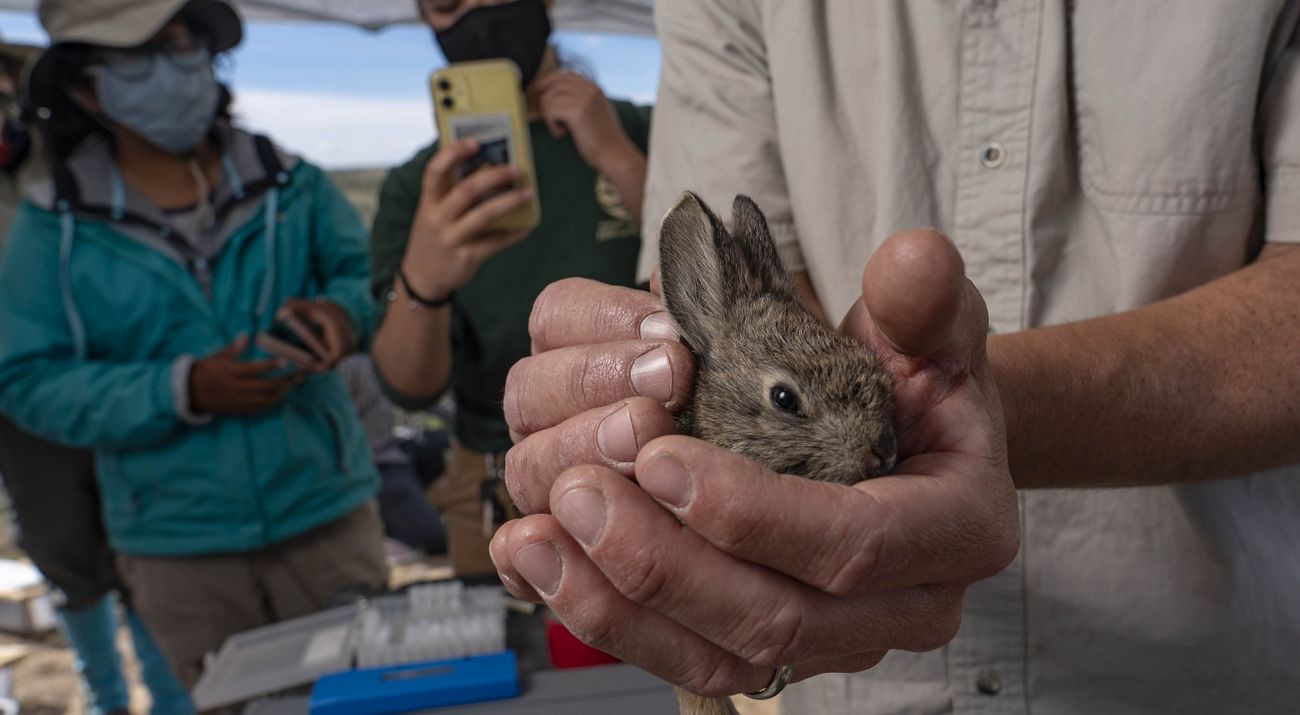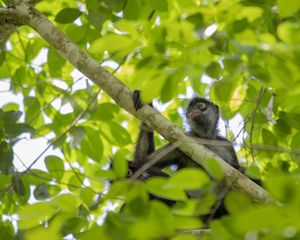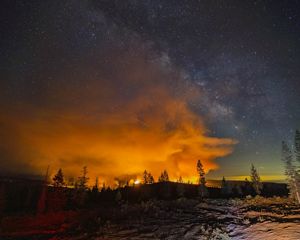A Big Plan to Save a Tiny Rabbit
For two decades scientists have fought to rescue America's smallest bunny.
Winter 2021
In June 2017, Jon Gallie, a wildlife biologist with the Washington Department of Fish and Wildlife, watched from a ridge as wildfire tore across the dry hills of eastern Washington. This shrub-steppe landscape is usually a serene expanse of pale green. Instead, a swirling maelstrom of smoke and flames was burning through acre after acre.
Gallie’s eyes stung from burning sagebrush. “Firefighters were asking us what the hell we were doing there,” he says. Some might argue the undeveloped shrublands might have been better left alone to burn. But Gallie had a singular reason to stay: He wanted to help protect the endangered species here that he had spent the last five years of his life working to restore.
Across the shrub-steppe, pygmy rabbits were sheltering in burrows in the fire’s path. Gallie and his crew were determined to do whatever they could to save the endangered animals, just as they had worked to save the rabbits from a seemingly endless series of disasters before.
The fire—which came to be known as the Sutherland Canyon Fire—was one of many obstacles Gallie and others have faced in two decades of attempts to boost the population of the Columbia Basin pygmy rabbit. With bodies about the size of a mango, they are North America’s smallest rabbit species, and among the only ones to dig their own burrows.
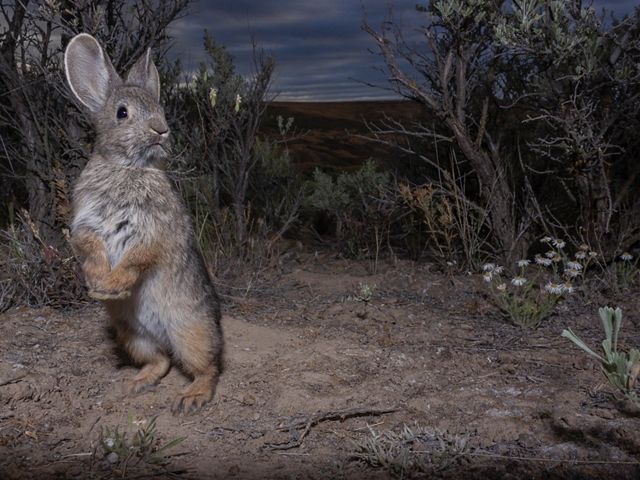
For thousands of years, these rabbits have lived on the Columbia Plateau, which stretches across eastern Washington and Oregon and into Idaho. Under normal circumstances, they play a critical role in the local food chain: They feast on the plateau’s pungent sagebrush for at least half of their diet, and in turn raptors, weasels and coyotes feast on them.
But human presence has battered their existence. The rabbits’ native habitat has been fragmented by development and farming. In 2001, biologists monitoring the rabbits could only find one colony, landing the species on the federal endangered species list. With fewer than 50 individuals left, the Columbia Basin pygmy rabbit was a whisker away from extinction.
In the last two decades, hopeful state and federal wildlife biologists, rabbit fans, farmers and ranchers, conservation research zoos, and nonprofits have all come together to give the rabbits a fighting chance against seemingly insurmountable odds. It’s not easy—even when the species they’re trying to save can breed like, well, rabbits.
“The highs are incredible moments of success and excitement, while the lows are crushing and catastrophic losses,” Gallie says of the effort. “But both are usually short-lived until the next game-changing event.”
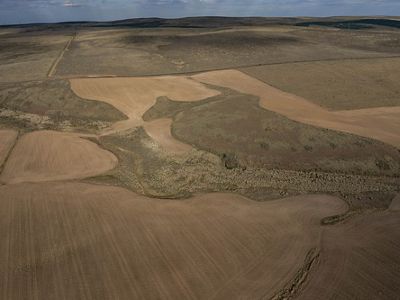
To Save the Rabbits, Save the Sagebrush
To understand the plight of the pygmy rabbit, you must also consider the state of the sagebrush habitat it depends on. Called the “sagebrush sea” for its vast, pale green uniformity, this landscape is deceptively rich, says Corinna Hanson, land manager for The Nature Conservancy’s Moses Coulee and Beezley Hills preserves in eastern Washington. Together, the preserves contain 33,000 acres of shrub-steppe—an arid ecosystem of grasses and shrubs, including many species of sagebrush.
In spring, showy yellow balsamroot, purple sagebrush violet and other flowers add bursts and blushes of color to the sea of green. Western meadowlarks trill in the morning’s soft light, mule deer move quietly across the hills, and small reptiles hide in the shadow of the sage. Altogether, this diverse habitat is home to more than 200 species of birds and at least 30 species of mammals, as well as reptiles and amphibians.
Since the 1700s, 80% of the sagebrush ecosystem in Washington has been lost to development and farming. And nearly 1 million more acres across the West are lost each year. In its place, cheatgrass—a fast-growing invasive weed—has quickly spread across portions of the region. An aggressive invader, it dries out early each year, making it highly flammable. Now, instead of burning every 30 to 100 years, fires can occur every five to 15 years, says Hanson. They’re also larger and more intense, she says.
That isn’t enough time for the sagebrush that defines this ecosystem to fully recover between fire cycles. Climate change is making the cycle of cheatgrass-wildfire-more cheatgrass worse as summers become hotter and drought increases, Hanson says. “A primary goal of a land manager here is to interrupt that cycle and maintain the native plant community before the tipping point, where it would become a permanent grassland, dominated by cheatgrass.”
Quote: Peter Lancaster
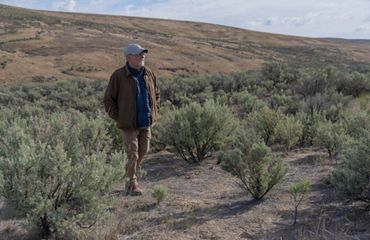
The pygmy rabbit is just one color in this landscape.
Since the early 2000s, TNC has worked with landowners, biologists, government agencies, nonprofits and volunteers to restore and conserve this ecosystem, boost bunny numbers and provide land for the rabbits’ reintroduction. The tens of thousands of acres of this threatened habitat that TNC protects and restores give the ecosystem and species dependent on it—including the pygmy rabbit, greater sage-grouse and sagebrush sparrow—a fighting chance of survival. And, in turn, species like the pygmy rabbit draw people in to care more about the oft-overlooked sagebrush sea.
One such person is Peter Lancaster, who grew up in the region and fell in love with the shrub-steppe and the rabbits.
He compares the rabbits and other species threatened by extinction to the dots and lines that together complete a painting. How many can be removed before a work of art becomes “unintelligible or uninteresting”? he says. “The pygmy rabbit is just one color in this landscape.”
In the 1990s, Lancaster scoured eastern Washington for signs of the tiny animals. In 1998, after two years of looking, he found an active burrow in what he calls “pristine sagebrush shrub-steppe” only to hear a road grader nearby: The land had just been purchased for development. What to do? “I contacted the investor and bought the entire parcel,” Lancaster says. A month later, Lancaster and his friend Paul Schuster purchased another parcel, just a short hop from the first.
Quote
With less than 50 individuals left in 2001, the Columbia Basin pygmy rabbit was a whisker away from extinction.
Launching a Rabbit Rescue
By 2001, though, when the rabbits were added to the federal endangered species list, protecting land wouldn’t be enough. It was time to launch a rabbit rescue. But figuring out how to help them breed and survive would take a lot of trial and error.
First, wildlife biologists from the Washington Department of Fish and Wildlife captured 16 of the remaining rabbits and brought them to breeding facilities at Washington State University, Oregon Zoo and Northwest Trek Wildlife Park. But captive breeding proved challenging, with little romance and poor survival rates. One main culprit: inbreeding and lack of genetic diversity among the small group of survivors.
So, in 2004, state Fish and Wildlife scientists launched a “genetic rescue.” They interbred the surviving Columbia Basin pygmy rabbits with Idaho pygmy rabbits, meticulously maintaining at least 75% Columbia Basin genes in each individual. Pregnancy and survival rates improved.
In 2007 the first batch of these captive-bred rabbits was released into protected shrub-steppe habitat. Within months, though, all 20 disappeared, most likely eaten by predators. After all, even wild-born pygmy rabbits have a natural survival rate of just 15%.


Biologists pivoted to a sort of bunny head-start program designed to prepare pygmy rabbits for life in the wild, says rabbit wildlife biologist Gallie. Starting in 2011, with volunteer help, the Washington Department of Fish and Wildlife fenced in four multi-acre coyote-proof enclosures on shrub-steppe habitat.
“It was like a Hilton hotel for rabbits,” says Gallie. “We provided every comfort.” Each enclosure—the size of several football fields—was equipped with PVC burrows along with netting to deter raptors. Rabbits were provided with some water and commercial rabbit food. There were even little shelters. Soon, the enclosures were hopping with baby bunnies, and the biologists cautiously began releasing them each year onto lands owned by TNC, state agencies and Peter Lancaster.
Efforts to track the rabbits grew. In winter, when snow helps reveal animal signs, Gallie and crews surveyed the release areas for evidence of survivors or their descendants. A tiny pawprint in the snow here, a fresh burrow and droppings there, a darting blur of brown fur—all were hopeful signs of live bunnies. Using fecal samples, the biologists can even track individuals, says Gallie.
“When a rabbit is released into the wild, we collect a small tissue sample to get its genetic ‘ID,’” he says. “Our partners with the University of Idaho conduct genetic analysis on these samples and can tell which rabbit they came from.” That data gave Gallie an estimate of how many released rabbits survived to adulthood, and how many are wild-born next generation.
The surveys also revealed a difference in survival rates between enclosure-bred rabbits and their wild-born offspring, and though the data was just emerging, something wasn’t quite right. In 2015, Gallie says, the survival rate of enclosure-bred rabbits in two areas was very poor. However, wild rabbits in one of those areas were surviving better.
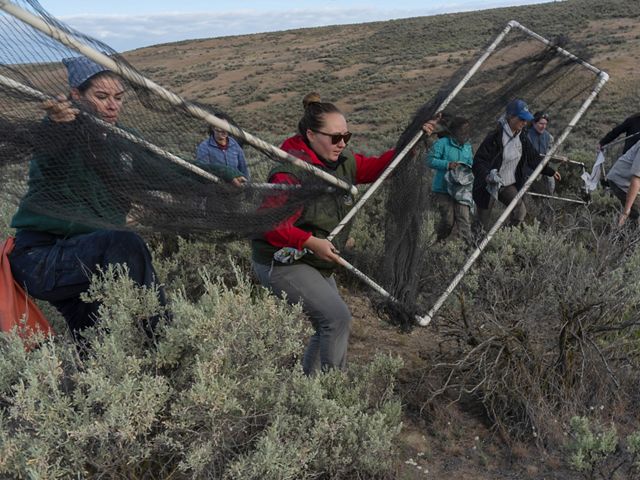
A Wildfire Forces a Setback
That all changed in 2017 as Gallie, standing on a ridgeline, watched flames spread toward the Beezley Hills breeding enclosure. In a last-ditch effort, he and the crew on-site raced to turn on irrigation, hoping to save some bunnies. Later Gallie and a group of firefighters, smiling through soot-covered faces, delivered more than 30 trembling little survivors to a relieved team of biologists. But at least 85 other pygmy rabbits perished, including 26 already living in the wild. “We lost our biggest and best breeding facility,” Gallie says.
Gallie now sees the 2017 fire as a blessing in disguise. “The enclosures were good at making the rabbits comfortable, and therefore also good for breeding lots of rabbits,” he says. “But they didn’t prepare them for life in the wild.” Perhaps the soft start at the “bunny Hilton” was a little too soft.
The breeding enclosures themselves had also begun to have dire problems, says Gallie. Seeds of invasive plants like cheatgrass had been stirred up when the fencing was installed. And the sagebrush the rabbits relied on had been overgrazed. Worse, a parasitic organism called coccidia, passed in decaying fecal matter, had spread rampantly, killing baby rabbits. “Since we had rabbits in the same area and same time show different survival rates, we concluded it was something we were doing that contributed to poor survival,” says Gallie.
Once again, Gallie and colleagues went back to the drawing board. They ditched the cushy permanent enclosures, which had ultimately developed so many issues. Instead, they pivoted to smaller, mobile breeding enclosures. “It’s called adaptive management,” Gallie says. Though the mobile enclosures still protect rabbits from many predators, the rabbits would have to dig their own burrows, and no more free lunch. “We wanted fewer, but hardier, rabbits,” he says.
Beginning in 2018, the biologists erected five such mobile enclosures in the region. If weeds or diseased fecal matter built up, it was just a matter of moving the fencing someplace else.
But then came 2020. In an agonizing replay, wildfire struck again. The Pearl Hill fire completely torched two enclosures along with a large reintroduction area, erasing three years of release efforts. Although biologists had been careful not to put all their bunnies in one basket, this fire killed 43% of all known Columbia Basin pygmy rabbits, wild or captive. Altogether, the 2020 fires burned 800,000 acres of shrub-steppe in Washington, including thousands of acres of recovery habitat. For pygmy rabbits, that habitat has now been destroyed for years to come, since they depend on mature sage at least 10 years old.
On top of everything else, biologists now face a new looming challenge: rabbit hemorrhagic disease. “It’s the bunny version of Ebola,” says Gallie. “It’s very lethal and contagious.” The crew is now vaccinating all enclosure rabbits and trapping wild rabbits to vaccinate them as well.


Cautious Hope for the Rabbits
Fires, made worse by climate change, along with shrinking and degraded habitat, disease, weeds—there always seems to be a new obstacle in the way of the rabbit’s recovery. “We often joke it’s like a bad movie,” says Gallie.
Still, even bad movies can have a happy ending. In summer 2021 the population of wild pygmy rabbits in Washington’s sagebrush sea was up to about 100, according to Gallie. That may not sound like many. But it’s a lot more than 16.
Those 100 rabbits represent two decades of intensive effort by biologists, research institutions, The Nature Conservancy, federal and state agencies, volunteers, landowners and private citizens. And ultimately, the species’ recovery is more about potential for growth than current numbers, says Hanson. That means preserving and restoring high-quality, protected habitat where newly released pygmy rabbits and their offspring can live and reproduce happily ever after, even as climate change exacerbates fires and drought.
After the 2015 fire, a new mobile enclosure and release area were placed on land owned by Peter Lancaster and the estate of Paul Schuster. In March 2021, Lancaster and Schuster’s estate donated a 282-acre parcel to TNC, specifically for Columbia Basin pygmy rabbit recovery. The acquisition expanded TNC’s Beezley Hills Preserve and offered new reintroduction habitat that had not been ruined by fire.
In spring 2021, Gallie was thrilled to see a population boom in this unburned portion of Beezley Hills. With new generations of wild-born pygmy rabbits breeding on their own, Gallie says the wild population is approaching a self-sustaining level. “We’re getting to the point where we can [eventually] remove ourselves from the equation,” he says. Though an indiscriminate tragedy like fire could change things at any time, Gallie is excited about this localized rabbit revival. “We now get to see the positive results of our activities for the last four years,” he says. “It was worth the wait.”
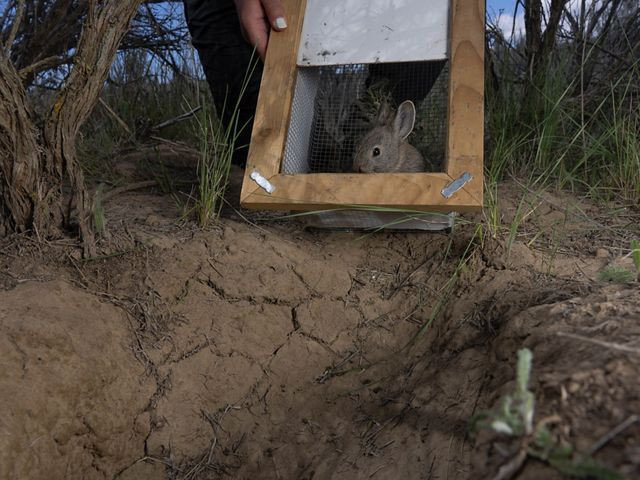
Of course, with the species still teetering on extinction, it’s not over yet. Wildlife biologists all over face a similar conundrum: Why do we work so hard to save a single species? Pygmy rabbits in eastern Washington, peregrine falcons in Canada, eastern indigo snakes in Florida—would it really make a difference if they disappeared? Is it worth the effort?
“We have a responsibility to help endangered species, especially those threatened by human activity,” says Corinna Hanson of the Conservancy. At the core of this responsibility, she emphasizes, is a dedication to restoring and conserving the habitat such species need to survive.
Gallie acknowledges that there is no single reason we work so hard to save one small species. “You either have a conservation ethic or you don’t,” he says. As a wildlife biologist, he knows that whether a species is flashy, cute or blandly obscure, each plays a unique role in its ecosystem. And for thousands of years, pygmy rabbits have played theirs among the sagebrush sea. “If these 100 rabbits blink out, we’ve lost part of Washington forever.”
